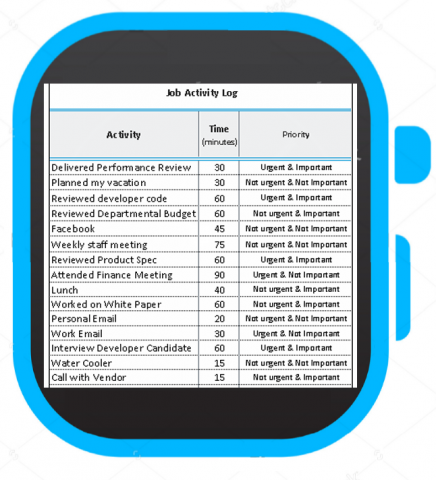Job Activity Log - the Fit-bit for Evaluating a Position

This article includes an editable Job Activity Log template and an accompanying instructions document for your staff and managers.
Don't want to read the entire article? Fair enough. We've highlighted the template in yellow so you can find and access it quickly.
Mad for Self Measurement
We're all mad for self measurement these days. Fit-bits, smart phones and apps that measure everything from heart rate to sleeping patterns, how many people liked your Instagram post, calories consumed and steps walked. These tools provide real data with which we can use to realize the end goal of self improvement.
It's interesting, however, that self measurement in the workplace is rare and often considered invasive or taboo. We rarely ask an employee to self monitor what they're working on or how long it takes to complete a task.
A Short HR Story
Melinda, an administrative assistant is desperate to share with me that her workload is unrealistic. She can't get her job done during working hours and the only way to fix the problem is to add more headcount.
Choi, a manager, approaches me with the same issue on behalf of a direct report. Again, the proposed solution in that first meeting is "we need more staff".
I always approach these visits to HR by trusting that staff and managers sincerely believe their plight to be true and they believe that adding more headcount is the only solution. That they're under pressure and feel the anxiety of no longer being able to execute on their responsibilities.
But rushing to solution is not the first step.
- The first step is to gather some data and find out how the individual is managing their time.
- What are they spending their time on?
- Are they working on the right tasks? How long is it taking them to complete them?
- How much distraction or interruption is occurring during a work day?
- The second step is to explore if the situation can be improved by:
- Reducing or eliminating time wasters and interruptions, or obsolete or redundant tasks
- Improving the employee's work environment
- Adopting more efficient methods to getting the job done; or
- Upgrading the employee's skills.
How are we Spending our Time at Work?
How much time do we spend at work doing things that don't contribute to job success? Our first response is inevitably, "not much." But we may be surprised by how much more time we can find to do the things that really matter.
When we understand how we use our time at work, we can minimize or eliminate low/no value activities and start doing more high value work. The end result? Higher productivity, less anxiety, and leaving the workplace on time at the end of the day.
Sign me up! How can I make this happen?
The tool to unleash more time is the Job Activity Log.
What's a Job Activity Log?
A Job Activity Log is a spreadsheet template used to provide your managers with a standard method for their staff to record individual job activities, the nature and time spent on each over a period of time, and the perceived urgency of the activity.
The data is then sorted/filtered/summed so the manager can work with the individual to understand if there are changes that can be made to support the employee.

 Sample Job Activity Log
Sample Job Activity Log
Take a look at a sample Job Activity Log template. It comes with an accompanying instructions document for your staff and managers. Both can be previewed, downloaded and edited using Microsoft Word & Excel.
Ways to Use the Job Activity Log
- To provide an individual with data for their own use when they want to measure their own productivity and priorities.
-
To provide input for a formal job description for a position. Completing the Job Activity Log ensures a manager, your company, HR, and the individual all understand the requirements of the role. The documented activities paint a realistic picture of the job and help to manage expectations.
- An individual has asked for their position to be reviewed, or a manager or your company is doing job analysis as part of a standard job evaluation process. Without a Job Activity Log, it's difficult to accurately review and/or evaluate the role to understand:
- The day-to-day job activities
- Levels of risk and responsibilities associated with the position
- The value/worth of a job in relation to other jobs in your company and the external market to establish a rational pay structure.
- To provide input to the annual review process. Completing the Job Activity Log helps you understanding how a role may be changing over time. This is especially important if you’re experiencing rapid growth since key responsibilities may be changing as frequently as every 3 to 6 months.
To support a performance improvement plan (PIP). When an employee's performance is not up to snuff relating to unmet deadlines and poor productivity, or where an employee is suspected of spending too much time on personal activities, you need a tool that can back up the poor performance and monitor improvement. The Job Activity Log is an indispensable tool in this case. The employee will often realize the employer's position while completing the Log for the first time and the self-disclosed data may end the performance issue on the spot. If not, the tool is administered towards the end of the PIP period to measure any improvements.
Managing Resistance to the Job Activity Log
Why Resistance?
The Job Activity Log should be called the Dreaded Job Activity Log. When an employee is asked to complete one, resistance, eye-rolling and big brother name calling often occurs. Why?
Here's a few possible reasons:
- Employees may be uncomfortable facing the data, let alone disclosing it. Head in the sand, plug my ears, ignorance is bliss, it I can't measure my productivity or efficiency - I won't have to fix it. (The feeling is similar to putting off a visit to the doctor when you know there's something not quite right.)
- No one wants to be monitored or audited. Employees expect unconditional trust from the employer and any process that damages that trust is seen as antagonist. (Not unlike being asked to take a lie detector test.)
- Humans may inheritably feel and worry that they're not good enough for the job. Any tool that may confirm this fear or result in job loss will be resisted. (Not unlike being asked to take an IQ test.)
- Some employees don't want to share or record what they do. We've all seen these types of employees who hoard all knowledge they hold about their positions like the Holy Grail. (Not unlike being asked to share the secret sauce to Grandma's meatloaf.)
- Employees may not want to give up their personal activities in the workplace. (Not unlike being asked to give up crack cocaine when you're addicted.)
Managing Resistance
As with most things, sensitivity and positioning are key elements to successfully using the Job Activity Log.
- Regardless of the reason for asking an employee to complete the Job Activity Log over a period of time, provide them with an opportunity to do a trial run first so they can understand what they're spending their time on before having to disclose the data. This is often a huge eye-opener that may instantly improve productivity. As mentioned, most of us don't have a clue about what we spend our time on, and how much time is spent on activities that don't add any value.
- Communicate the benefits of using the tool for both your company and the employee, spending more effort on the latter.
- Unless completing the Job Activity Log is related to a PIP, be very clear and transparent about the reasons for using the tool and assure the employee that the end goal is not termination. The end goal is to understand what the employee is spending their time on and make adjustments accordingly so the employee is working on the right things and ultimately feels less anxiety and pressure.
- Wherever possible, don't single out an individual and ask them to use the tool. Where possible, make the exercise applicable to a department, team, or globally throughout your company.
Feel the Discomfort & Do it Anyway
You may find that no matter how sensitively you position or approach the exercise, employees may not always support you in your request to complete a Job Activity Log. But at the end of the day, you have the right to manage your business, and your managers' responsibilities include understanding the job details and productivity levels of their direct reports.
Resistance to the process is not a reason for you to avoid proceeding with the request. If you've approached the request in the right way, stand your ground. You may be surprised to find that employees appreciate the exercise when it ultimately results in less anxiety and higher productivity for them when they understand how much time they may be wasting on activities that aren't core to their jobs. That in the end, they have the power to change the way they work.
Last Word
Job Activity Logs are useful tools for:
- Understanding redundant or obsolete tasks
- Reducing/eliminating time wasting or personal activities
- Understanding all low-value activities in a department and perhaps even adding a cost-effective position to delegate these activities to
- Understanding productivity challenges with some tasks.
Use it!
- Download a sample Job Activity Log template to avoid blank page syndrome. It's always easier to edit than create. Then customize it for your company.
- If you're looking for other documents to support the Job Evaluation function, check out the Job Evaluation toolkit.
- Also available is a full solution for Setting up an HR Department using editable documents.
- Or sign up for a free trial.

Ariane Laird is CEO & Founder of ConnectsUs HR. Contact her directly from the Inquiry Type drop down menu.

